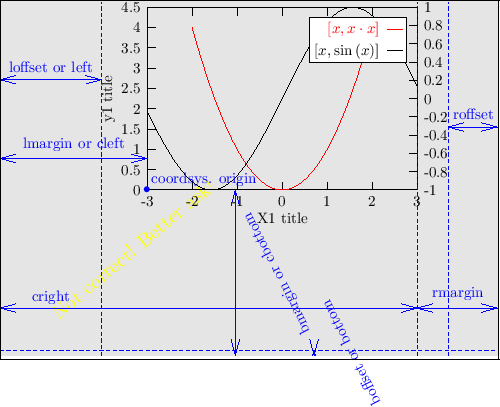- What is a frame?
- The current frame
- Setting a grid
- Setting the title
- The legendbox
- Mirroring axis tics
- Fixing aspect ratio to reflect plotted range
A wrapper function exists to easily set the title of the current frame:
set::title("Title of frame");
This is a rectangular area within the frame, where the legend of the
plotted graphs (a short explanation with sample from the graph's
drawstyle) is shown. The C++ object is legendbox, and this can be accessed
by frame's member function: legendbox *legend();
Positioning the legendbox: The legendbox (within the frame) can be positioned by the following member function of frame:
legendpos(int xalign,int yalign)where xalign can be sym::left, sym::center or sym::right, and yalign can be sym::bottom, sym::center or sym::top. These give the possibility for a quick alignment of the legendbox to the different corners of the frame. By this method the ticlengths of the axes are also taken into account, so that they do not overlap with the legendbox. The following example puts the legendbox to the upper left corner of the frame:
frame::current().legendpos(sym::left, sym::top);
For more precise alignment of the legendbox you can use the methods of legendbox inherited from box. For example:
frame::current().legend()->left(2*CM);To switch on/off mirroring of axis tics, you can say: frame::current().mirror_y1(false), etc.
Sometimes you do not want the axes and the frame to be drawn. To switch off axis drawing, call the draw_frame(false) function on a specific frame. To switch off frame drawing globally, call the static frame::default_draw_frame(false) function: all frames created after this statement will not draw themselves. (The script producing the following plot is here).

There are two ways to fix the aspect ratio of a frame:
- To call the caspect(double y_per_x) function, which fixes the printed aspect ratio to the given value.
- However, a more useful thing might be the nodistort(true)
function, which will cause that the printed aspect ratio of the frame
will be identical to the ratio of the plotting y- and x-ranges (for
the x1 and y1 axes. Does not work with logscale). This is useful if
your x and y variables correspond to some geometrical distances (for
example x and y coordinates), and you want to have the picture without
distortion.
To set nodistort for the current frame, you can use the shorthand set::nodistort(true) instead of writing frame::current().nodistort(true)
frame::current().lmargin(!frame::current().cwidth()); frame::current().caspect(1.0);



